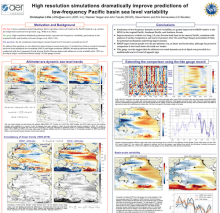High resolution simulations dramatically improve the representation of tropical Pacific sea level trends
Christopher
Little
Atmospheric and Environmental Research, Inc.
Poster
Current generation coupled climate models generally do not capture the altimetry-era sea level trend pattern in the tropical Pacific, which is characterized by lower rates of rise in the Eastern Pacific than in the West. Although other, non-sea level, observational records suggest a systematic bias in climate models (e.g., Wills et al. 2022), the altimetry record is relatively short, making it difficult to robustly conclude that regional sea level trends are inconsistent in models and observations. Here, we first improve the basis for such an assessment by using: 1) sea level observations from tide gauges, dating back to the early 20th-century; and 2) initialized, coupled, simulations. Tide gauge records provide a longer verification dataset for skill assessments of initialized simulations, and suggest that the dynamic sea level trend observed over the altimeter era is part of a low-frequency internal mode.
We then leverage these observational diagnostics to examine the skill of sea level hindcasts in low-resolution (DPLE) and high-resolution (HRDP) decadal prediction simulations conducted with the Community Earth System Model (CESM) over the 1976-2019 period. HRDP simulations exhibit substantially higher skill than DPLE in key regions of the Pacific, resulting from improved simulation of both long-term trends and higher-frequency sea level variability. Consistent with other recent studies, our analysis suggests that it is necessary to resolve small-scale (high-frequency) phenomena in order to adequately represent emergent long term trends in climate.
We then leverage these observational diagnostics to examine the skill of sea level hindcasts in low-resolution (DPLE) and high-resolution (HRDP) decadal prediction simulations conducted with the Community Earth System Model (CESM) over the 1976-2019 period. HRDP simulations exhibit substantially higher skill than DPLE in key regions of the Pacific, resulting from improved simulation of both long-term trends and higher-frequency sea level variability. Consistent with other recent studies, our analysis suggests that it is necessary to resolve small-scale (high-frequency) phenomena in order to adequately represent emergent long term trends in climate.

Poster file
little-chris-confronting-poster.pdf
(5.01 MB)
